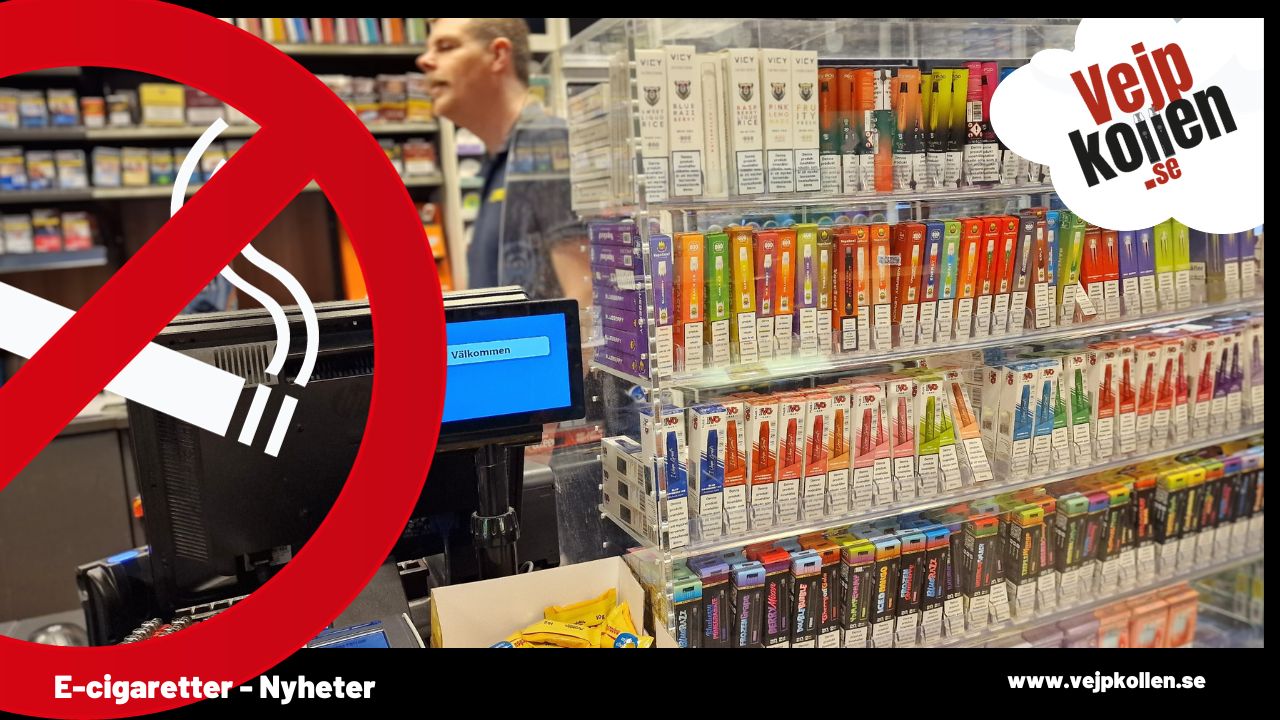Fewer Swedes are buying cigarettes. But the more people are buying nicotine pouches and vejps. CAN states this in your latest report on nicotine sales in Sweden.
"Cigarettes will disappear. Politicians and authorities can either speed up the process or try to delay it. But in the end, it doesn't really matter. New nicotine products are taking over now, no matter what they do." says Karl-Åke Johansson, spokesperson for the Swedish Vejpare Association.
Smoking in Sweden continues to decline and so do cigarette sales. At the same time, both sales and use of alternatives to cigarettes in the nicotine market are increasing. This is shown in two recent reports published by Central Association for Information on Alcohol and Drugs., CAN.
"If daily smoking continues to decline at the same rate as in recent years, the target of less than 5 per cent daily smoking by 2025 is achievable." CAN states
Snus and e-cigs are taking over
In 2022, around 7 per cent of the Swedish population smoked cigarettes daily and 6 per cent were occasional smokers. Snus use has increased dramatically and the proportion of vejp users has risen from 2 per cent to 4 per cent.
"This confirms something we users have been saying for a long time. Cigarettes are really going away. Older Swedes seem to prefer snus and younger people are turning to new smoke-free products such as e-cigarettes and nicotine pouches." says Karl-Åke Johansson, a spokesperson for The Swedish Vejpare Association, part of the New Nicotine Alliance Sweden.
Fewer cigarettes in circulation
In addition to the decrease in the proportion of smokers, the number of cigarettes reported by daily smokers has also decreased. On average, a daily smoker today smokes about 15 fewer cigarettes per week compared to a daily smoker 20 years ago.
Mats Ramstedt, research officer at CAN, has compared sales figures with the annually reported use of nicotine products in Sweden.
'The use of tobacco cigarettes has fallen sharply over the last 20 years, by 40 per cent. At the same time, the use of tobacco snuff has increased sharply, by 65 per cent. Then there are the new nicotine products that we have measured for the first time based on sales data, where we can now confirm that there are large increases in sales between 2021 and 2022," says Mats Ramstedt. TV4 News.
E-cigarettes sell significantly better
The use of e-cigarettes has increased significantly, especially among younger people and particularly among younger women. According to the report, the amount of e-liquid sold in Sweden has increased from 4 000 litres to 14 000 litres over the last two years. This coincides with the introduction of disposable models in convenience stores. However, Mr Ramstedt says that it is not yet possible to link this development to the continued decline in tobacco smoking.
Noticeable in small shops
Nonetheless, these trends were already identified in the spring, when the industry organisation Convenience Store Swedens latest report on customers' shopping habits and attitudes in members' shops.
"E-cigarettes and nicotine pouches have established themselves on the shelves. At the same time, a large proportion of those who usually buy nicotine products say they would consider trying smokeless products instead of smoking. This is a clear sign of a change in attitude that affects sales." states Convenience Stores Sweden in Vejpkollen.
Fronting with e-cigs, not cigarettes
According to Karl-Åke Johansson you only have to look in any convenience store or petrol station to connect the statistics with the market trend.
"The disposable models have established the e-cig in a way that the traditional vejp products never could. The shops are fronting them. They are everywhere, I can travel around the Borås area where I live and buy an e-cig in any shop. Just like you've always been able to do with cigarettes."
Smoke-free nicotine attracts
According to Karl-Åke Johansson it's only a matter of time before cigarettes become a commodity that stores no longer make a profit from selling. However, nicotine pouches, snus and e-cigarettes will attract customers to shops in the same way that cigarettes once did.
"Say what you like about disposable models, but together with snus they will take over more and more. Whether we like it or not. Customers are talking with their wallets. And with that, smoking, or rather cigarette sales, are likely to be marginalised within 10-15 years. Politicians and responsible authorities can either postpone the inevitable or speed up the process. Of course, the best thing would be for the MSN to ensure that as many smokers as possible understand the benefits of switching from cigarettes to e-cigs or snus," says Mr Higgins. Karl-Åke Johansson.
Positive developments - for public health
Karl-Åke Johansson believes that this development can only be seen as positive. At least from a harm minimisation perspective. Different forms of nicotine use carry different risks, and there is currently a consensus among researchers that the use of smokeless nicotine carries little to no risk of developing several smoking-related cardiovascular diseases, lung diseases such as COPD and emphysema, and several types of cancer. Some increased risk of type 2 diabetes is suspected to be related to snus use, as well as temporary stiffening of blood vessels when using nicotine via e-cigarettes. But even here, risk levels are significantly higher for smokers.
"No nicotine use is completely risk-free. The problem is rather that many interest groups read the figures as if they were reading the Bible. What we actually see is that those who want to use nicotine nowadays simply choose not to use the most harmful way of doing so. And that is actually a really good development. Sweden stands out in that we actually use as much nicotine as other countries, mainly via snus and nicotine pouches. But we do not die from smoking-related diseases to the same extent as in countries where smoking is still very high." says Karl-Åke Johansson.
More young people vejpaking - fewer smoke regularly
Disposable vapes began to be sold in regular shops, that is, outside the more niche vejp shops, as late as 2020. The use of e-cigarettes among minors, meanwhile, increased sharply in 2021 - 2022. This year it has decreased again, although sporadic use is still higher than before 2020. The more regular use of e-cigarettes among young people is marginally higher than the use of cigarettes. Four per cent of ninth graders and three per cent of secondary school students used e-cigs regularly, while around two per cent smoked regularly. Before 2020, the share of
"We now have clear age limits that we must ensure that shops comply with. If young people get hold of e-cigarettes or snus anyway, it's either because the shops don't check the age of those who buy them, because they are dealing to each other, or because the black market is involved. Right now, authorities need to understand how this market works. E-cigarettes are NOT like regular cigarettes. New models appear, trend quickly, disappear and are replaced by something else. The serious shops that comply with laws and regulations can't keep up and can't compete with black market players, not with the current system." says Karl-Åke Johansson.
Need to crack down on illegality
He argues that authorities controlling e-cigarette sales need to be better at detect the illegal sale. And it's not just about age checks, but also what products are actually on the shelves.
"All sales to minors are prohibited. But the seizures made by the police from young people indicate that these are unregistered products, often with a much higher nicotine content and capacity than those that ordinary shops are allowed to sell. These products are attractive to adults as well, and this is where the gangs make the most money. Politicians need to look at this more closely and find solutions so that the controlled market, where age limits and controls actually apply, at least has a chance to reach the adults who are otherwise fuelling the black market. When legal products become more attractive than illegal ones, the incentive for organised criminals to get involved decreases. When that interest disappears, so does the supply of products aimed at young people," says Mr Perez. Karl-Åke Johansson.




